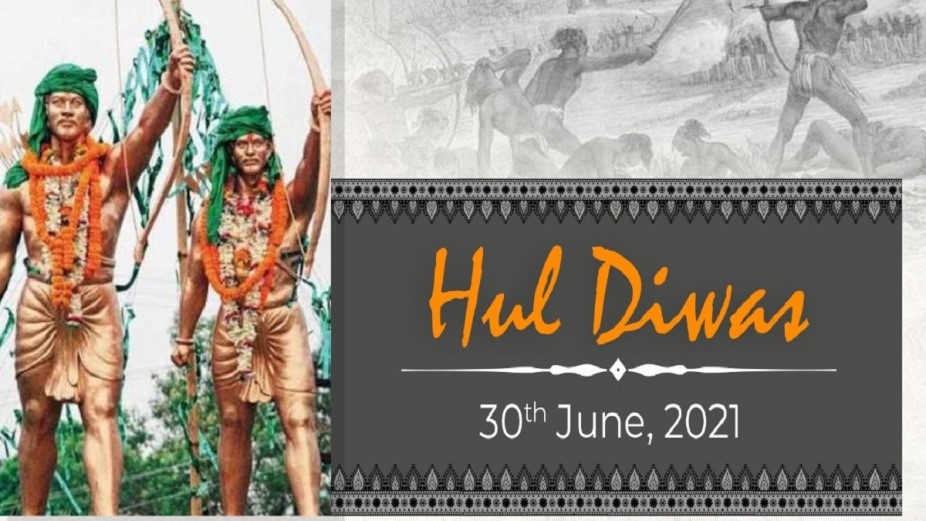Description

Disclaimer: Copyright infringement not intended.
Context
- On Hul Diwas, PM modi, through a tweet, remembered Santhal rebellion and sacrifice made by adiwasis in their fight against British colonial authorities
- In state of Jharkhand, June 30 is celebrated as Hul Diwas.
Other Details
- Hul Diwas marks the beginning of the Santhal rebellion.
- Santhals are also referred as Santal by some experts.

Santhal Rebellion
- Hul literally means revolution.
- The Santal/Santhal rebellion, considered the first war for Indian independence by some historians, began in 1855.
- Led by Santal community it was an organised war against colonial economic oppression.
Leader and participation
- The rebellion was led by two brothers Sidhu and Kanhu,
- Inpired from the brother, around 32 caste and communities joined this revolt and surprised the british.
Regions
- Forested Damin-i-Koh region (skirts of hills)
- It lies in the present-day Jharkhand which is around the Rajmahal Hills of eastern Jharkhand’s Sahibganj district.
Background of Santhals
- In late 18th century, the Santal people –migrated to Santhal Pargana (currently in districts of Dumka, Pakur, Godda, Sahibganj, Deoghar and parts of Jamtara) from the West Bengal (Birbhum and Manbhum).
- The main reason for migration was the 1770 famine in Bengal.
- British settled them in Damin-i-Koh region for the purpose of collecting tax and generating revenue.
- They were further exploited by money-lenders and the police.
- Today, the Santal community is the third largest tribal community in India, spread across Jharkhand-Bihar, Odisha and West Bengal.
Reasons for Hul/ Santhal Rebellion
- The adverse social and economic conditions of Santals were the main cause of revolt as observed by Calcutta Review.
- Oppressive extortions, forced eviction from land, abuse and personal violence by Zamindars, the police, the revenue and court were the common occurrence.
- Some forms of exploitations were -
- Loan rates as high as 500%.
- False measures at the haut and the market.
- Intentional trespassing and illegal capturing of their untethered cattle, tattoos, ponies, elephants.
- Destruction or control of growing
Start of the revolt
- In tribal councils and meetings, discussion surrounding the adverse exploitation and rebellion were frequent by 1854.
- Finally 6,000 Santhals from 400 villages were gathered in an assembly held on June 30, 1855 and declared autonomy from the British.
- Two brothers Sidhu and Kanhu made leader to mobilize Santal people across the region.
- Participation of Santals in revolt was massive, approximately 60,000 Santhals, and many of them took up arms.
- Many non-Adivasi Hindu castes also participated.
- Moneylenders and zamindars were killed or forced to evict the region.
- Many police stations, railway stations and post offices were attacked and burnt.
Was it organized rebellion ?
- At first glance this revolt seems unorganised chaotic uprising However there are evidence that suggest it to be highly organised rebellion.
- Some evidences, given in a book by Ashwini Pankaj -
- Formation of guerrillas and military teams to prepare for war.
- Spy network creation.
- Many secret bases were set up.
- For smooth coordination, a network for logistics and message carriers was created.
Other facts about the Hul
- To control this uprising British resorted to various brutal tactics -
- They invoked the Martial Law and killed thousands of
- British also burned down villages.
- They hanged people on various corners of the road.
- Around 32 communities (tribals and non-tribals both) participated in revolt.
- Phulo-Jhano sisters commanded an army of 1,000 women.
- Main aim of this army was to provide food supply, gathering intelligence and to attack the East Indian camps during the night.
- During the rebellion army of EIC was defeated twice.
- The rebellion was suppressed by 1856. However, according to Inder Kumar Choudhary, the Santals in Hazaribagh and Manbhum area participated in the mutiny of 1857 too.
British Narrative
- After the complaints and instances of exploitation, various british officers examined the situation however they considered mahajans the main cause behind revolt. They found -
- No signs of over taxation(land rent) was found.
- Justice for Santhals was inaccessible and far off.
- Mahajans (money lending) were inflicting sufferings which needed to be addressed.
Prisoners’ account after the Hul
- The book HUL DOCUMENTS records mentioned about the dream of a deity -
- Deity appeared in front of Kanoo Sonthal and a Parwana (an order) to the Bada Sahib in Calcutta was sent afterwards.
- The deity also asked Seedo Sonthal to kill british officieres, Pontet and the Darogah, and Mahajuns.
|
PRACTICE QUESTION
Consider the following statements about Santhal Rebellion:
1. Hul Diwas marks the beginning of Santhal Rebellion.
2. Santhal rebellion is also considered the first war for Indian independence by some historians.
Which of the statements given above is/are correct?
A. 1 only
B. 2 only
C. Both 1 and 2
D. Neither 1 nor 2
Answer: (C)
|

https://indianexpress.com/article/explained/explained-history/hul-diwas-remembering-the-santal-rebellion-against-the-british-8696023/







